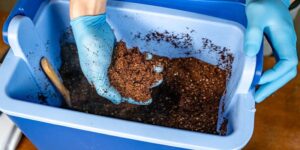Larch/ Tamarack

Larix laricina
Larch are a deciduous conifer tree that grow in wet areas as far north as Canada and as far south as West Virginia. Bark of mature trees are reddish brown with younger trees showing a smooth gray bark. Needles grown in blue-green clusters and turn a goldish color in fall. Needles and cones are perfect for bonsai as both are small to begin with, the cones are only 1 to 2 cm.
Style: are usually grown as informal upright trees. They are also grown in groves or group plantings, root on or over rock, slanting and semi-cascade styles. (Owen, 29) (Samson, 66-67)
Placement: Full sun during the growing season, can be grown in partial sun. During times of extreme summer heat, move to partial sun or place in a shallow tray of water. Very cold tolerant down to -80F
Watering: Larch are a high water mobility plant as should be kept moist at all times, water as soon as surface shows signs of drying out. Larch also does not like hard water, best to use collected rain water as they prefer a neutral or slightly acidic pH.
Pruning & Wiring: Larch takes regular pruning well. If larger branches must be pruned, this should be done in winter or early spring, before the tree starts growing. Avoid cutting back mature trees to the same points again and again because this would produce ugly knobs and promote senescence. Odd and badly positioned buds should be removed before they open. The twigs are shortened to two buds where possible. Larches have sticky resin which makes cut paste obsolete, and grow strong callus tissue which closes cut wounds quite quickly. In summer the long shoots are shortened when they have grown 4–6″ long (10-15cm) and the buds near the base of the shoots become visible. Larches can be wired during winter dormancy, before the fragile buds begin to swell in spring. Younger branches of the larch and golden larch are quite flexible and can be shaped easily with wire and guy wires. The twigs and branches thicken quickly during the growing season and the wire must be taken off in time before it bites into the bark too deeply. Moderate wire marks will grow over quite soon, at the latest when the bark becomes flaky. (Bonsaiempire.com)
Repotting: Larch are vigours growers and may need to be repotted more often than your average conifer. Repotting must be done in the spring before buds are open, and remove less than a third of the root mass.
Additional Reading:
Bonsai Times #79 (Club collection)
And please remember, the books and magazines are available from our PSBS library on this and many other bonsai topics.



